Vertex standard VXA-210 Manual

AIR BAND TRANSCEIVER
Operating Manual
VXA-210
1 |
2 |
3 |
4 |
5 |
6 |
7 |
8 |
9 |
MW |
0 |
F |

CONTENTS
Important Notice! ........................................................... |
1 |
Introduction .................................................................... |
2 |
Controls & Connectors ................................................. |
3 |
Top Panel .............................................................................. |
3 |
Front Panel ........................................................................... |
4 |
LCD Display ........................................................................ |
5 |
Keypad .................................................................................. |
6 |
Left Side ............................................................................... |
7 |
Right Side ............................................................................. |
8 |
Before You Begin ........................................................... |
9 |
Precaution ............................................................................. |
9 |
Battery Installation and Removal ....................................... |
9 |
Battery Charging ................................................................ |
10 |
Low Battery Indication ...................................................... |
11 |
Installing the FBA-25 (option) Alkaline Battery Case .... |
11 |
Operation ...................................................................... |
12 |
Preliminary Steps ............................................................... |
12 |
Operation Quick Start ........................................................ |
12 |
Squelch Adjustment .................................................... |
14 |
Accessing the 121.5 MHz Emergency Frequency ........... |
14 |
Tuning Methods ................................................................. |
15 |
Transmission ...................................................................... |
16 |
Reception of Weather Channel Broadcasts ...................... |
16 |
Monitor Key ....................................................................... |
18 |
ANL (Automatic Noise Limiter) Feature ......................... |
18 |
Temperature Display .......................................................... |
19 |
LOCK Function ................................................................. |
19 |
Receive Battery Saver Setup ............................................. |
20 |
Beep On/Off ....................................................................... |
21 |
Barometric Pressure/Altitude Metering ................... |
22 |
Thermometer Calibration .................................................. |
22 |
Correcting the Atmospheric Pressure Meter (Barometer Offset) .. |
23 |
Correcting the Altimeter setting (Altimeter Offset) ......... |
23 |
How to Measure the Rarometric Pressure or Altitude ..... |
24 |
Weather Sensor Mode ....................................................... |
24 |
Memory Operation ....................................................... |
26 |
Memory Storage ................................................................. |
26 |
Recalling the Memories..................................................... |
27 |
Scanning Operation .................................................... |
28 |
Channel-Skip Scanning ..................................................... |
29 |
Dual Watch Operation ................................................. |
30 |
Priority Dual Watch Operation ................................... |
31 |
VOR Navigation ............................................................ |
32 |
To Select the DVOR Mode ............................................... |
33 |
Flying to a VOR Station .................................................... |
34 |
Entering a Desired Couse .................................................. |
36 |
Position Cross-checking .................................................... |
37 |
Split Operation ................................................................... |
38 |
Field Programming Mode ........................................... |
39 |
Memory Storage into the Book Memory ......................... |
39 |
Menu (“Set”) Mode ...................................................... |
40 |
Menu Listing ...................................................................... |
41 |
Installation of the SU-1 ............................................... |
45 |
Accessories & Options ............................................... |
46 |
Specifications ............................................................... |
48 |
NOTICE
There are no user-serviceable points inside this transceiver. All service jobs must be referred to your Authorized Service Center.

IMPORTANT NOTICE!
FCC RF Exposure Compliance Requirements for Occupational Use Only:
This Radio has been tested and complies with the Federal Communications Commission (FCC) RF exposure limits for Occupational Use/Controlled exposure environment. In addition, it complies with the following Standards and Guidelines:
rFCC 96-326, Guidelines for Evaluating the Environmental Effects of Radio-Frequency Radiation.
rFCC OET Bulletin 65 Edition 97-01 (1997) Supplement C, Evaluating Compliance with FCC Guidelines for Human Exposure to Radio Frequency Electromagnetic Fields.
rANSI/IEEE C95.1-1992, IEEE Standard for Safety Levels with Respect to Human Exposure to Radio Frequency Electromagnetic Fields, 3 kHz to 300 GHz.
rANSI/IEEE C95.3-1992, IEEE Recommended Practice for the Measurement of Potentially Hazardous Electromagnetic Fields - RF and Microwave.
¦This radio is NOT approved for use by the general population in an uncontrolled environment. This radio is restricted to occupational use, work related operations only where the radio operator must have the knowledge to control its RF exposure conditions.
¦When transmitting, hold the radio in a vertical position with its microphone 1 to 2 inches (2.5 to 5 cm) away from your mouth and keep the antenna at least 1 inch (2.5 cm) away from your head and body.
¦The radio must be used with a maximum operating duty cycle not exceeding 50%, in typical Push-to- Talk configurations.
DO NOT transmit for more than 50% of total radio use time (50% duty cycle). Transmitting more than 50% of the time can cause FCC RF exposure compliance requirements to be exceeded.
The radio is transmitting when the red LED on the top of the radio is illuminated. You can cause the radio to transmit by pressing the P-T-T button.
¦Always use Vertex Standard authorized accessories.
 1
1
VXA-210 PILOT OPERATING MANUAL

INTRODUCTION
The Vertex Standard VXA-210 Pilot is a compact, stylish, solid hand-held transceiver providing communication (transmit and receive) capability on the International Aircraft Communication Band (“COM” band: 118 ~ 136.975 MHz), and it additionally provides VOR and CDI navigation features on the “NAV” band (108 ~ 117.975 MHz).
The VXA-210 includes Temperature display with our exclusive Omni-GlowTM display back-light for minimal degradation of your night vision, NOAA weather band monitoring, 8-character Alpha/Numeric Display, 50 Memory Channels, and 100 “Book Memory” Channels. And the optional Barometric Pressure Unit (SU-1) provides readout of barometric pressure, altitude, and density altitude.
We recommend that you read this manual in its entirety, so as to understand the many features of the VXA-210 completely. Keep this manual handy, so you may use it for reference.
NOTE: The VXA-210’s VOR and CDI Navigation features are supplemental aids to navigation only, and are not intended to be a substitute for accurate (primary) VOR/CDI or landing service equipment. And also, the Barometric/Altitude features of the optional SU-1 are not designed to be a substitute for accurate, calibrated Barometer or Altimeter devices used for navigation critical to personal safety.
Congratulations!
You now have at your fingertips a valuable communications tool-a Vertex Standard two-way radio! Rugged, reliable and easy to use, your Vertex Standard radio will keep you in constant touch with your colleagues for years to come, with negligible maintenance down-time.
Please take a few minutes to read this manual carefully. The information presented here will allow you to derive maximum performance from your radio, in case questions arise later on.
We're glad you joined the Vertex Standard team. Call on us anytime, because communications is our business. Let us help you get your message across.
2 
VXA-210 PILOT OPERATING MANUAL
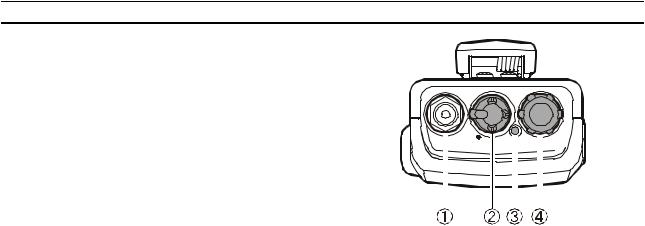
CONTROLS & CONNECTORS (TOP PANEL)
 Antenna Jack
Antenna Jack
This SMA jack accepts the supplied flexible antenna, or another antenna designed to provide 50 W impedance on the Aircraft Communication Band.
 POWER/VOLUME Knob
POWER/VOLUME Knob
Turn this control clockwise to turn the radio on and to increase the volume. Counterclockwise rotation into the click-stop will turn the radio off.
 BUSY/TX Indicator Lamp
BUSY/TX Indicator Lamp
VOL DIAL
This lamp glows green when a signal is being received and red when transmitting.
 DIAL Selector Knob
DIAL Selector Knob
This 20-position detended rotary switch tunes the operating frequency or selects the memory channels.
Pressing this knob downward momentarily selects the tuning methods among the VFO (Variable Frequency Oscillator), MR (Memory Recall), BOOK (Pre-Programmed Memories), and WX (Weather Channel Memories) mode.
Note: The WX mode is available in the USA version only.
 3
3
VXA-210 PILOT OPERATING MANUAL
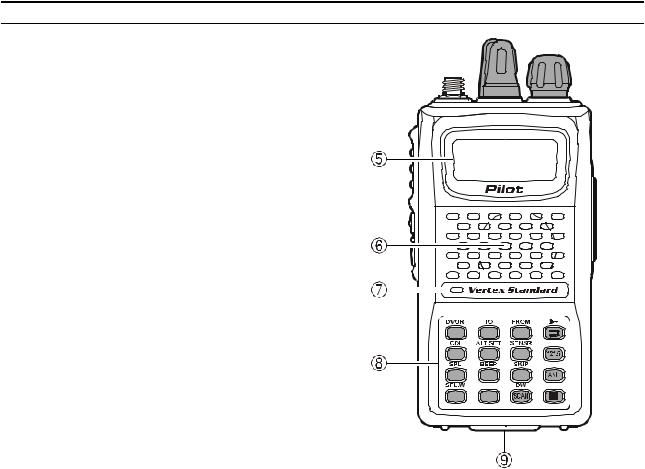
CONTROLS & CONNECTORS (FRONT PANEL)
 LCD (Liquid Crystal Display)
LCD (Liquid Crystal Display)
The display shows the selected operating conditions as indicated on the next page.
 Loudspeaker
Loudspeaker
The internal speaker is located in this position.
 Microphone
Microphone
Speak across this opening in a normal voice level while pressing the PTT switch, to transmit.
 Keypad
Keypad
Several keys have dual functions.
The primary functions are labeled on the key top (activated by simply pressing the key momentarily), while the secondary functions are labeled in yellow above the top edge of the key (activated by pressing the [F] key first, then the indicated key).
These functions are described in detail on page 6.
 Battery Pack Latch
Battery Pack Latch
Open this latch for battery removal.
1 |
2 |
3 |
4 |
5 |
6 |
7 |
8 |
9 |
MW |
0 |
F |
4 
VXA-210 PILOT OPERATING MANUAL
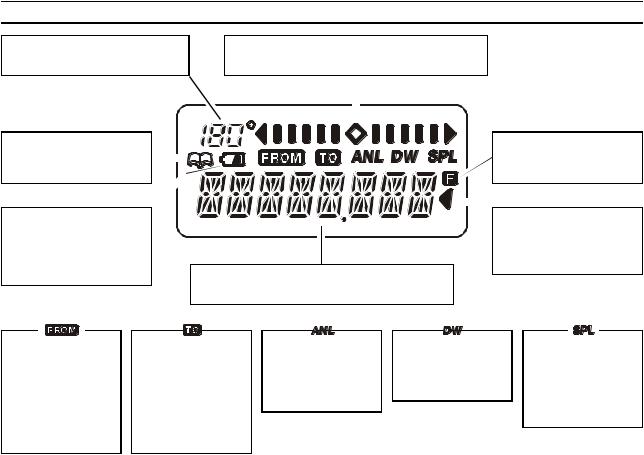
CONTROLS & CONNECTORS (LCD DISPLAY)
This field displays the course heading in degrees. See page 33.
This icon indicates that the “Book” Memory Bank is in use. See page 15.
This icon is the “Low Battery” indicator, which blinks when the battery voltage becomes too low for proper operation.
This is the Course Deviation Indicator, used during VOR Navigation. See page 32.
These digits provide frequency or alphanumeric information about the channel you are using.
This indicator confirms that Secondary Key Function is active. See page 6.
This indicator confirms that this channel will be skipped during scan. See page 29.
This icon is used during VOR navigation, to indicate that the displayed information is based on a course from the VOR station. See page 33.
|
|
|
|
|
|
|
|
|
|
|
|
|
|
|
|
|
|
|
|
|
|
|
|
|
|
|
|
|
|
|
|
|
|
|
|
This icon is used |
This indicator con- |
This indicator con- |
|||||||||
during VOR naviga- |
firms that the AUTO- |
f i r m s t h a t D U A L |
|||||||||
tion, to indicate that |
MATIC NOISE LIMITER is |
WATCH is active. See |
|||||||||
the displayed infor- |
activated. See page |
page 30. |
|||||||||
mation is based on |
18. |
|
|
|
|
|
|||||
a course to the VOR |
|
|
|
|
|
|
|||||
station. See page |
|
|
|
|
|
|
|||||
33. |
|
|
|
|
|
|
|
|
|
|
|
This indicator confirms that the “Split” (Duplex) mode is a c t i v a t e d d u r i n g VOR operation. See page 38.
 5
5
VXA-210 PILOT OPERATING MANUAL
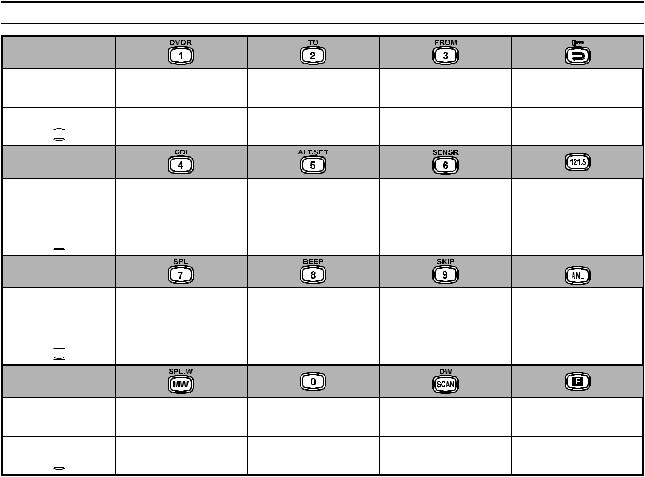
CONTROLS & CONNECTORS (KEYPAD)
Primary Function
(Press Key)
Secondary Function (Press 

 + )
+ )
Primary Function
(Press Key)
Secondary Function (Press 

 + )
+ )
Primary Function
(Press Key)
Secondary Function (Press 

 + )
+ )
Primary Function
(Press Key)
Secondary Function (Press 

 + )
+ )
Frequency Entry |
Frequency Entry |
Frequency Entry |
|
Digit 1 |
Digit 2 |
Digit 3 |
|
Activates DVOR mode |
Selects |
Selects |
|
“TO” VOR mode |
“FROM” VOR mode |
||
|
|||
Frequency Entry |
Frequency Entry |
Frequency Entry |
|
Digit 4 |
Digit 5 |
Digit 6 |
|
Activates Course |
Activates the |
Activates the Sensor |
|
Deviation Indicator mode |
Altimeter Set function |
Functions |
|
Frequency Entry |
Frequency Entry |
Frequency Entry |
|
Digit 7 |
Digit 8 |
Digit 9 |
|
Activates Split (Duplex) |
On/Off Switch for |
Allows Skipping of |
|
mode |
Keypad Beeper (page 21) |
Channel during Scan |
|
Memory “Write” |
Frequency Entry |
Activates Scanning |
|
Command |
Digit 0 |
||
|
|||
Split-Memory “Write” |
None |
Activates Dual Watch |
|
Command |
|||
|
|
Selects Memory Display
Type (page 27)
Locks the Keypad
Selects Emergency
Channel (121.5 MHz)
None
Activates Automatic
Noise Limiter
None
Activates “Secondary”
Key mode
None
6 
VXA-210 PILOT OPERATING MANUAL
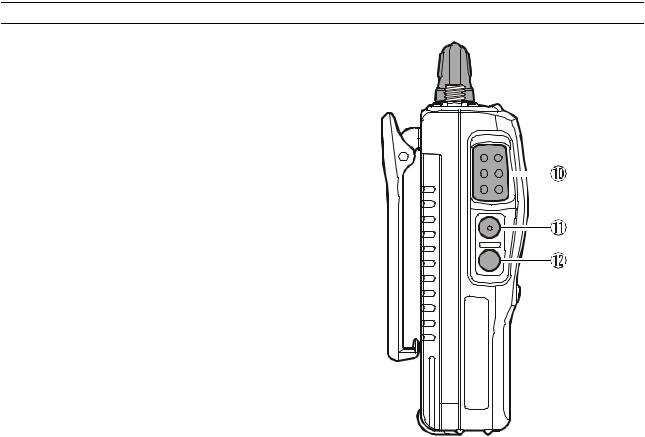
CONTROLS & CONNECTORS (LEFT SIDE)
 PTT (PUSH TO TALK) Switch
PTT (PUSH TO TALK) Switch
Press this button to transmit when you are operating in the COM band. Release this button to return to the “RECEIVE” mode. See page 16.
 MONITOR Switch
MONITOR Switch
This button may be pressed to “open” the squelch manually, allowing you to listen for very weak signals. Press and hold this button for 2 seconds to “open” the squelch continuously. Press this button again to resume normal (quiet) monitoring. See page 18.
 LAMP Switch
LAMP Switch
Pressing the LAMP switch momentarily will illuminate the display and keypad for five seconds, after which the back-lighting will automatically turn off. Press and hold this switch for 2 seconds to activate the back-lighting lamp continuously. To turn the lamp off, press this switch again. The LAMP switch may be configured in several ways via the Menu; see page 43 for details.
 7
7
VXA-210 PILOT OPERATING MANUAL
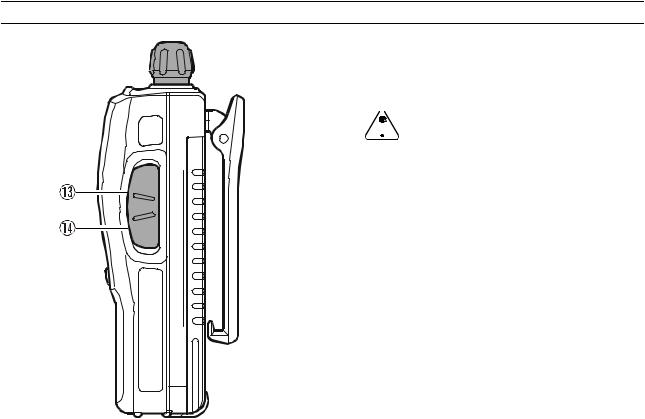
CONTROLS & CONNECTORS (RIGHT SIDE)
MIC /SP
EXT
DC
 MIC/EAR Jack
MIC/EAR Jack
You may connect the supplied CT-60 Headset Cable or the (optional) MH-44A4B Speaker/Microphone to this jack.
 Never connect any Speaker/Microphone
Never connect any Speaker/Microphone  that is not recommended by the manufacturer. Because these jack connections are unique,
that is not recommended by the manufacturer. Because these jack connections are unique,
using a Speaker/Microphone that is not specified by Vertex Standard may damage the VXA-210.
 EXT DC Jack
EXT DC Jack
When an external 12-Volt DC power source is available, you may connect the (optional) E-DC- 5B External DC Cable here. Do not connect any wire to this jack if that wire is connected directly to a 28-Volt DC source. Connecting the
VXA-210 directly to a source which exceeds 15.0 Volts DC will result in damage to the unit.
8 
VXA-210 PILOT OPERATING MANUAL
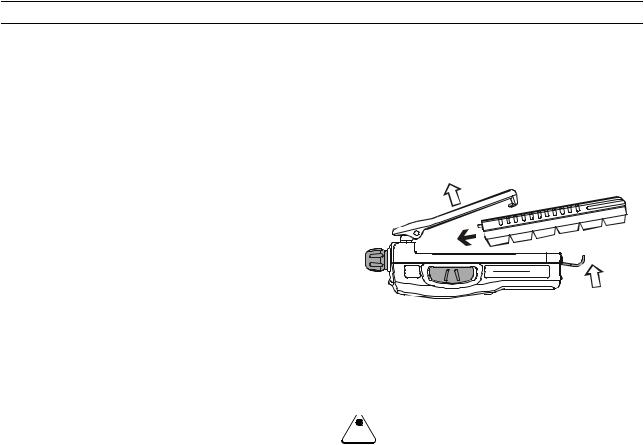
BEFORE YOU BEGIN
Precautions
rThis apparatus is capable of two-way communication on channels used for critical aviation safety communications. Therefore, it is important that this radio be kept away from children or other unauthorized users at all times.
rWhen making DC connections via the (optional) E-DC-5B DC cable, be absolutely certain to observe the proper voltage level and polarity guidelines. Do not connect this radio directly to any 24 ~ 28 Volt DC source, nor to AC power of any kind. Connecting the VXA-210 directly to a source which exceeds 15.0 Volts DC will result in damage to the unit.
rDo not dispose of the Ni-Cd Battery Pack in a fire. Do not carry a Ni-Cd Battery Pack in your pocket, where keys or coins could short the terminals. This could create a serious fire/burn danger, and possibly cause damage to the Ni-Cd pack.
rAlthough the VXA-210 is designed to be water resistant, the enclosure is not “waterproof.” Do not allow the radio to become submersed in water, and do not expose it and/or its Ni-Cd Battery Pack to water spray under pressure.
Battery Installation and Removal
¦To install the battery, hold the transceiver with your left hand, so your palm is over the speaker and your thumb is on the top of the Belt Clip. Insert the battery pack into the battery compartment on the back of the radio while tilting the Belt Clip outward, then close the Battery Pack Latch until it locks in place with a “Click.”
|
|
|
|
|
ck |
|
|
|
|
ry |
Pa |
|
|
|
te |
|
|
|
|
e |
Bat |
|
|
Tilt the Belt Clip |
stall |
th |
|
|
|
|
In |
|
|
|
|
MIC /SP |
EXT DC |
Close the Battery Pack Latch
¦To remove the battery, turn the radio off and remove any protective cases. Open the Battery Pack Latch on the bottom of the radio, then lift the battery upward and out from the radio while tilting the Belt Clip upward.
 Do not attempt to open any of the recharge-
Do not attempt to open any of the recharge-  able Ni-Cd packs, as personal injury or damage to the Ni-Cd pack could occur if a cell or cells
able Ni-Cd packs, as personal injury or damage to the Ni-Cd pack could occur if a cell or cells
become accidentally short-circuited.
 9
9
VXA-210 PILOT OPERATING MANUAL
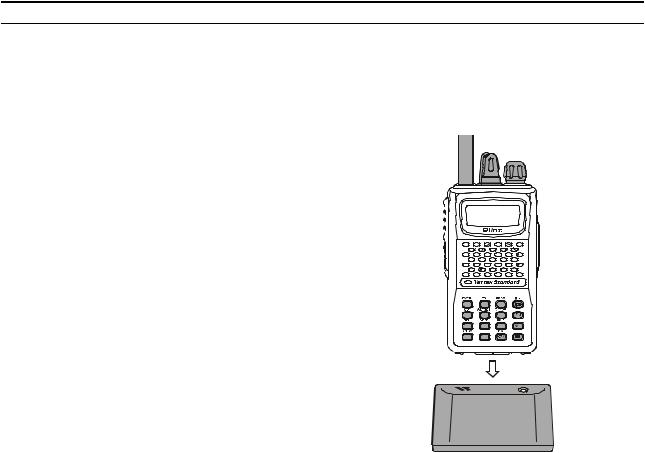
BEFORE YOU BEGIN
Battery Charging
It is necessary to fully charge the Ni-Cd battery before its first use. Follow these procedures:
¦Install the supplied FNB-64 Ni-Cd battery pack onto the transceiver. Ensure that the transceiver is switched off.
¦Plug the NC-77 into the AC line outlet.
¦Insert the transceiver and battery pack into the NC-77; the antenna jack should be at the left side when viewing the charger from the front.
¦If the transceiver and battery pack are inserted correctly, the RED indicator will glow. A fullydischarged pack will be charged completely in 10 hours.
Important Notes:
rThe NC-77 is not designed to power the transceiver for operation (reception or transmission).
rDo not leave the charger connected to the transceiver for continuous periods in excess of 24 hours. Long term overcharging can degrade the Ni-Cd battery pack and significantly shorten its useful life.
rIf using a charger other than the NC-77, or if using a battery pack other than the FNB-64, fol-
low the appropriate instructions provided with the charger/battery. Contact your Dealer if you have any doubts about the appropriateness of the particular charger or battery pack you intend to use.
1 |
2 |
3 |
4 |
5 |
6 |
7 |
8 |
9 |
MW |
0 |
F |
VXA-210/NC-77
10 
VXA-210 PILOT OPERATING MANUAL
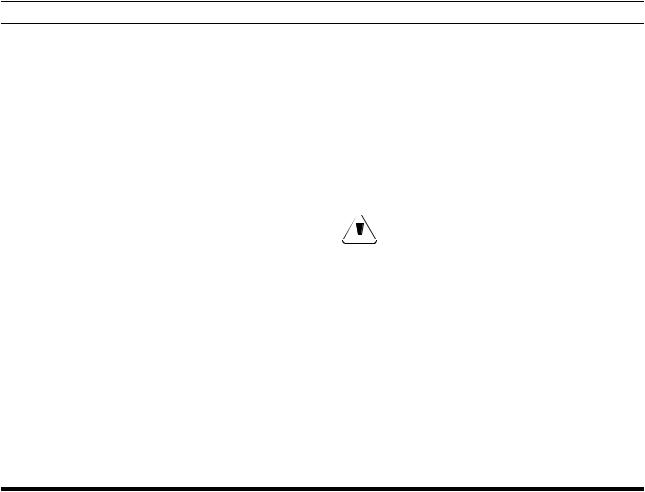
BEFORE YOU BEGIN
Low Battery Indication
¦As your battery discharges during use, the voltage will gradually become lower. When the battery voltage reaches 6.0 Volts, the “  ” icon will blink on the LCD display, indicating that the battery pack must be recharged before further use.
” icon will blink on the LCD display, indicating that the battery pack must be recharged before further use.
¦Avoid recharging Ni-Cd batteries before the “Low Battery” indicator is observed, as this can degrade the charge capacity of your Ni-Cd battery pack. Vertex Standard recommends that you carry an extra, fully-charged pack with you so you will not lose communications capability due to a depleted Ni-Cd battery.
This “deep cycling” practice will help to maintain longer overall battery life after many recharging cycles.
Installing the FBA-25 (option) Alkaline Battery Case
The optional FBA-25 Battery Case allows operation of the VXA-210 using six “AA” size Alkaline batteries.
When installing batteries, insert the (–) end first, then press in the (+) end so the battery snaps into place. Always replace all six batteries at the same time, paying attention to the polarity indicated inside the case.
 The FBA-25 must not be used with re-
The FBA-25 must not be used with re- 

 chargeable cells. The FBA-25 does not contain the thermal and over-current protection cir-
chargeable cells. The FBA-25 does not contain the thermal and over-current protection cir-
cuits (provided in the “FNB” series of Ni-Cd Battery Packs) required when utilizing Ni-Cd cells.
11
VXA-210 PILOT OPERATING MANUAL
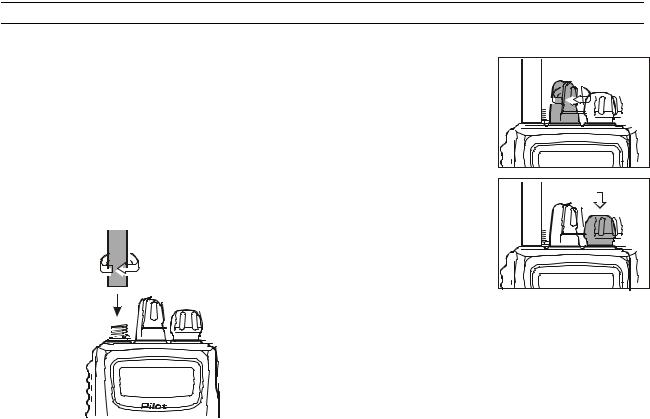
OPERATION
Preliminary Steps
¦Install a charged battery pack onto the transceiver, as described previously.
¦Screw the supplied antenna onto the Antenna jack. Never operate this transceiver without an antenna connected.
¦If you have an optional Speaker/Microphone or headset, we recommend that it not be connected until you are familiar with the basic operation of the VXA-210.
Operation Quick Start r To turn the radio on,
rotate the VOLUME knob out of the click-stop.
r After three “initial- |
|
ization” beeps are |
Press |
heard, a channel fre- |
|
quency should ap- |
|
pear on the display. |
|
If not, press down- |
|
ward (momentarily) |
|
on the DIAL selector knob (repeatedly, if necessary) so that “ - VFO -” appears on the display, followed by a channel frequency.
rDirectly entering frequencies from the keypad is the easiest method if you know the frequency on which you wish to operate. Just enter the five digits of the frequency to move to that frequency. For example, to set 134.35 MHz,
press [1] à [3] à [4] à [3] à [5].
12 
VXA-210 PILOT OPERATING MANUAL
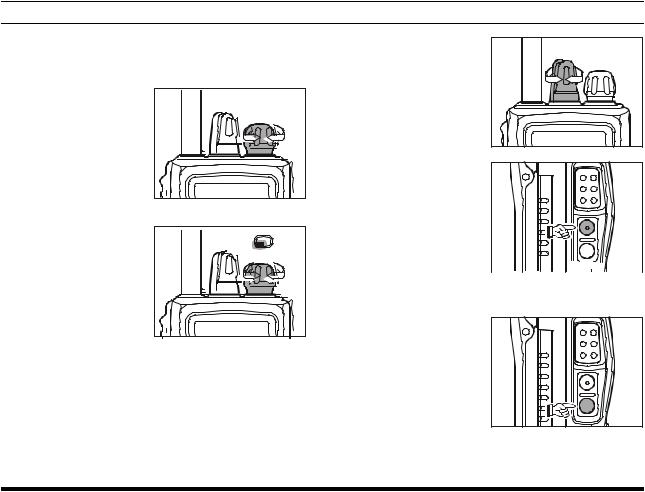
OPERATION
To set 118.275 MHz, you do not need to press the final “5” in the frequency:
[1] à [1] à [8] à [2] à [7].
r You may also turn |
|
|
the top panel’s DIAL |
|
|
selector knob to |
|
|
choose the desired |
|
|
operating frequency. |
|
|
The channel fre- |
|
|
quency will appear |
|
|
on the LCD. |
|
|
r T o c h a n g e f r e - |
|
|
quency in 1 MHz |
F |
|
+ |
||
steps, press the [F] |
||
|
||
key momentarily, |
|
|
then rotate the DIAL |
|
|
selector knob to se- |
|
|
lect the MHz digit |
|
|
desired. Press [F] once more to resume normal |
||
channel selection in 25-kHz steps. |
|
|
r Rotate the VOL-
UME knob to set the volume level. If no signal is present,
press and hold the
MONITOR button for 2 seconds; background noise will now be heard, and you may use this noise to set the VOLUME knob for the desired audio
l e v e l . P r e s s t h e  MONITOR button momentarily to silence the noise and resume normal (quiet) monitoring.
MONITOR button momentarily to silence the noise and resume normal (quiet) monitoring.
r Press and hold the LAMP button for 2 seconds, to illuminate the display continuously. To disable the illumination, press the LAMP button momentarily.
13
VXA-210 PILOT OPERATING MANUAL

OPERATION
r To turn the radio off, turn the VOLUME knob fully counterclockwise into the click stop position.
Squelch Adjustment
1.Press the [F] key momentarily, then press downward on the DIAL selector knob to activate the Menu (“SET”) mode.
2.Rotate the DIAL selector knob to select the Menu Item 01 “SQL.”
3.Press downward on the DIAL selector knob, then rotate the DIAL selector knob to set the squelch threshould (0 to 8) so that the receiver is just silenced. A higher number indicates that a higher signal level is required in order to open the squelch.
4.Press downward on the DIAL selector knob to save your new setting.
5.Press the PTT switch to exit the Menu (“SET”) mode.
Accessing the 121.5 MHz Emergency Frequency
The VXA-210 can quickly access the 121.500 MHz Emergency Frequency. This function can be activated even when the keypad lock function is in use.
rTo access the Emergency Frequency, press the [121.5] key momentarily.
rTo exit the Emergency Frequency, press downward on the DIAL selector knob.
2 |
3 |
5 |
6 |
8 |
9 |
0 |
F |
Press |
14 
VXA-210 PILOT OPERATING MANUAL
